| Construction Rating: | starstarstarstarstar_border |
| Flight Rating: | starstarstarstarstar |
| Overall Rating: | starstarstarstarstar_border |
| Published: | 2010-01-13 |
| Diameter: | 0.98 inches |
| Length: | 38.10 inches |
| Manufacturer: | FlisKits  |
| Skill Level: | 4 |
| Style: | Futuristic/Exotic |
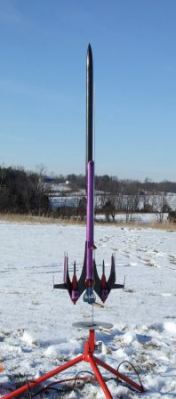
Brief:
For those that want a bit more of a challenge than the traditional 3FNC, consider the Decim8, which as Nigel Tufnel
would say, goes to eleven, and that's better than 3, innit? This kit is a challenging build rated at skill level 4, but
will reward the careful modeller with a beautiful futuristic alien battle ship.
Construction:
Numbered kit 44 has been sacrificed for this build, as I jumped on this one shortly after it was released. The part
quality is very good. My first impression looking over the spread of parts was "that's a whole lot of body tubes
for just one nose cone".
The parts list includes:
- BT-50 body tubes--2 18" lengths, 2 9-inch lengths
- BT-20 motor/stuffer tube
- BT-60 ring fin
- BT-2.5 body tube (2)
- Balsa nose cone (1 for BT-55 2 for BT-2.5's)
- 20/50 centering rings (4)
- 20/5 centering ring motor block
- Balsa fin stock
- Laser-cut fiber fins (8)
- Ping pong ball transition
- Wood dowel for trim
- Kevlar®+elastic shock cord
- Plastic chute
- Waterslide decals
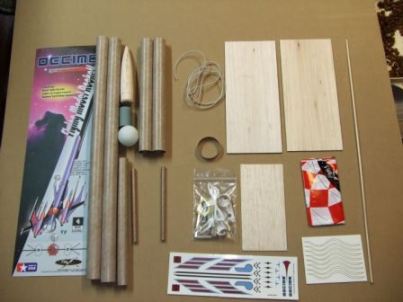
This is one project where you DO NOT want to open the bag, read the directions through, then start building. Take my advice and put away all glues. OK, now start working through the directions cutting, shaping, sanding the pieces, following the very well written and illustrated directions. You'll spend the better part of a weekend afternoon or a few weeknights just creating the various pieces involved. Now lay everything out, dry fitting subassemblies where possible, and take a good look at the thing. Unless you want to wimp out and fly it nekkid, or go with a basic 1-2 color paint scheme, you're going to need to spend a considerable amount of time getting your head around how to finish this model--which tube spirals to fill (some inside spirals as well), what to mask, what to spray, what to paint by hand, etc. There are so many funky shapes and joints involved in this that you simply can't go about doing a decent finish job on an already built model unless you have exceptional skills.
That said, this is rated a skill level 4 kit and probably worthy of that rating, though the Fliskits Saturn 1b rates between a 3 and 5 depending on level of complexity modelled, and I would rate this a good step or two below that in terms of challenge. The construction and basic build is not hard at all, just a significant amount of work. The finishing can be extremely challenging, but not that bad if planned out in advance. Unfortunately, the instructions are by necessity generalized and walk through construction, leaving finishing to the modeller, though there are warnings throughout that consideration should be made to pre-painting where applicable.
 Construction starts by working on the ping pong ball (ppb) transition. In other kits involving ppb's, you
generally use a body tube to mark a circle, cut it out, then insert the tube and use the shadow of the tube to mark the
corresponding circle on the other half of the ppb. That technique doesn't quite work in this case, because one of the
holes is sized for a BT-20 and the other for a BT-50, plus one of the launch lugs rests against the BT-50 and goes
through the ppb. To deal with this problem, you get a wrap-around template to slip over the ppb, marking both holes and
launch lug slot locations. It's a little tricky to work with, especially since circle patterns don't wrap over the
surface of a sphere very well, so I cut the circles a bit undersized on purpose, then sanded them open a bit as needed
for a good fit around the tubes.
Construction starts by working on the ping pong ball (ppb) transition. In other kits involving ppb's, you
generally use a body tube to mark a circle, cut it out, then insert the tube and use the shadow of the tube to mark the
corresponding circle on the other half of the ppb. That technique doesn't quite work in this case, because one of the
holes is sized for a BT-20 and the other for a BT-50, plus one of the launch lugs rests against the BT-50 and goes
through the ppb. To deal with this problem, you get a wrap-around template to slip over the ppb, marking both holes and
launch lug slot locations. It's a little tricky to work with, especially since circle patterns don't wrap over the
surface of a sphere very well, so I cut the circles a bit undersized on purpose, then sanded them open a bit as needed
for a good fit around the tubes.
The motor tube is a BT-20 with thrust ring, metal hook, and pair of centering rings to slide into a BT-50. It's a fairly long BT-20, serving as a stuffer tube to help build up pressure through the roughly 36" length of BT-50 that the ejection charge would have to push through to deploy a chute. That's a bit much for an 18mm motor, thus the use of the extended BT-20 to reduce the volume of interior air that needs to be moved. The BT-20 gets marked for 8 coolant fins via a wrap-around guide, to be dealt with later.
The BT-50 also gets marked for the same 8 coolant fins using another wrap-around guide, as well as a number of fins. Be careful extending lines, as there are so many lines so closely spaced they can run together. The instructions suggest only extending the coolant fin lines up about 2", and the other fin lines starting at about 2" and extending the length of one of the BT-50's. I'll toss out another tip from one of my D'oh! moments, which I believe Jim is addressing in subsequent runs of the kit. When mating the BT-20 to the BT-50, you're supposed to make sure the coolant fin lines synch up. There are 8 lines on each tube, so taking any one line on the BT-20 and lining it up to a matching line on the BT-50 leaves 8 options, all of which would work. 2 of those options would be bad, though. As you line them up, pay attention to where the engine hook on the BT-20 sits. Look further down along that line towards the BT-50 and see what fin lines that sits near. If your hook is anywhere near either of the two "main fin" lines, rotate the BT-20 and line up to a different coolant fin line. This is because the main fins wind up anchoring to the BT-20 and the BT-50, and you don't want one of them sitting on the motor hook, as was the case with my build.
I should point out, by the way, that along with all the tube marking, there's plenty of tube cutting involved as well. There's almost no regular, squared end tube treatment on this model. I think only the motor tube and two little BT-2.5 tubes slipped into side pods wind up going onto the model without some level of scalloping.
In the case of the lower BT-50, the forward end gets trimmed and slotted. The upper BT-50 gets trimmed and
slotted on one end, and if done correctly, the two trimmed ends slide together along the slots, overlapping through
about half the diameter. That leaves two structural issues--the need for a stronger joint than two slots in the tubes,
and something to seal off the air flow to enable pressurized ejection through what is basically a ducted tube joint.
The structural issue is handled by a pair of little
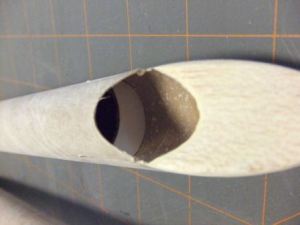 crescent
shaped braces formed using laser-cut bulkheads attached to a cutaway section of centering ring. The air seal issue is
handled via balsa bulkheads cut to a roughly parabolic shape, then sanded and trimmed to fit in the ends of the mated
tubes. This is one of those construction steps where it's critical to plan the paint first. If you build
"stock", you attach the crescent supports to the outside of each tube, slide them together, then
cut/trim/glue in the balsa panels. I wanted a perfect fit for the panels and wanted to fill the grains, so they had to
be glued in before joining the tubes together, which meant my crescent supports had to be premounted on the insides of
the tubes rather than the outsides. This probably doesn't make sense reading it, but if you look at the photos, then
imagine trying to mount the supports externally you'll see there's no way to slide the tubes together.
crescent
shaped braces formed using laser-cut bulkheads attached to a cutaway section of centering ring. The air seal issue is
handled via balsa bulkheads cut to a roughly parabolic shape, then sanded and trimmed to fit in the ends of the mated
tubes. This is one of those construction steps where it's critical to plan the paint first. If you build
"stock", you attach the crescent supports to the outside of each tube, slide them together, then
cut/trim/glue in the balsa panels. I wanted a perfect fit for the panels and wanted to fill the grains, so they had to
be glued in before joining the tubes together, which meant my crescent supports had to be premounted on the insides of
the tubes rather than the outsides. This probably doesn't make sense reading it, but if you look at the photos, then
imagine trying to mount the supports externally you'll see there's no way to slide the tubes together.
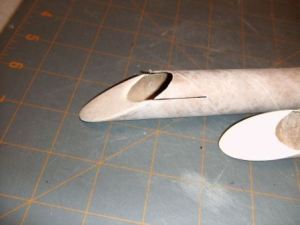
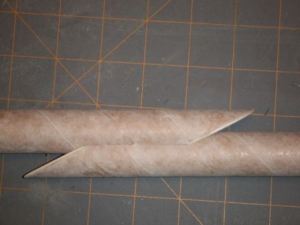
Moving along, with the BT-50's trimmed and mated, and the BT-20 stuffer tube glued into the lower BT-50, you then slide the ppb transition over the BT-20, sliding the larger hole over the BT-50, until the BT-50 hits the inside wall of the ppb. Insert a launch lug, trim the ends (another case where this is much easier to do offline before gluing on the ppb), and then mount another lug further up the line.
With the ppb in place, next up is mounting the coolant fins. These are 8 laser-cut fiber fins that are just amazing. They have tiny root feet that mount to the BT-50 just ahead of the ppb, then they curve around the ppb and touch down on the BT-20 that extends out beyond the aft end of the BT-50. They then curve back up from the BT-20 and sort of hang out a couple inches behind the BT-20 like the tentacles of an octopus. There's a small section of BT-60 that slips inside these tentacles, perfectly fitting. Of course, this is probably another one of those cases where if you want the ppb, coolant fins, BT-20 and/or BT-60 to be anything other than a single color, if you've used glue at this point you're in [deep dudu].
Building up the lower BT-50 now, the main fins go on. They have long roots, then have arced cut outs to slip over the ppb, and very small root sections that reach down to anchor to the BT-20.
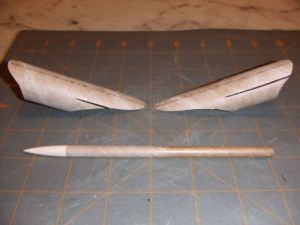 Each
main fin gets a side pod subassembly attached to the tip. The side pods are a very funky assembly of two pieces of
scalloped and sliced BT-50 that slide together, with a section of BT-2.5 slipped inside their seam. A balsa nose cone
fits the BT-2.5 finishing the subassembly. In the photos, you can see that in my case, I painted each BT-50 piece
independently, masking off between colors at the slot where they join together. I also decided not to actually paint
the tube interiors that would be exposed, but instead used some blue glittery contact paper purchased from Aerospace
Speciality Products. The BT-2.5 and cones got black metallic pre-paint before assembly. Try painting these
subassemblies anything other than one main color--I dare ya...
Each
main fin gets a side pod subassembly attached to the tip. The side pods are a very funky assembly of two pieces of
scalloped and sliced BT-50 that slide together, with a section of BT-2.5 slipped inside their seam. A balsa nose cone
fits the BT-2.5 finishing the subassembly. In the photos, you can see that in my case, I painted each BT-50 piece
independently, masking off between colors at the slot where they join together. I also decided not to actually paint
the tube interiors that would be exposed, but instead used some blue glittery contact paper purchased from Aerospace
Speciality Products. The BT-2.5 and cones got black metallic pre-paint before assembly. Try painting these
subassemblies anything other than one main color--I dare ya...
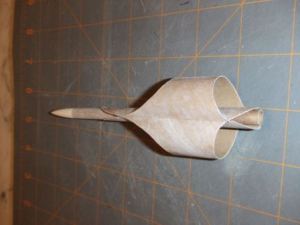
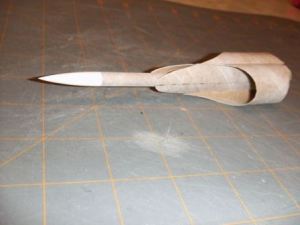
There's still more to build out beyond the pods--each gets a pair of fins mounted into the tube seams, with the fins spread out at about a 70 degree angle (aided by a little cut out angle template). The tip of each of these fins gets a wood dowel gun, trimmed to match the angle of the fins.
But wait, there's more. I said there were 11 fins, and so far we've only covered 6 (those coolant fins don't count). Each of the pod fin pairs gets another extension type fin tacked into their root joint, basically extending the main fin line if everything has been mounted correctly. Those, in turn, get tiny little guns mounted to them that are built up from a toothpick, wrapped with paper or tape, slipped into an 1/8" launch lug.
OK, that's 8. 3 more to go...On the "bottom" of the lower BT-50 there are a pair of cut off arc fins/stabilizers. You'll find very few fins on this use nothing but straight lines, which had me muttering to myself as I was cutting everything out.
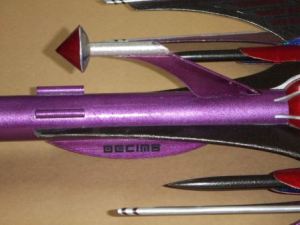 Still leaves us with one fin. On the top of the lower BT-50 is something called an antenna. Apparently
spaceships don't have cable TV, so they need something resembling a satellite dish, and for proper reception it has to
be raised up a bit to avoid the cosmic interference of the coolant fins. There's one fin acting as an antenna mount
(naturally, with a curved leading edge). At the tip of this goes a short section of BT-2.5 (scalloped, of course--can't
have squared tubes on this beauty). On the end of that goes the antenna, which consists of a rolled paper cone front
section, glued to one of the cut out sections from the ppb for the back end.
Still leaves us with one fin. On the top of the lower BT-50 is something called an antenna. Apparently
spaceships don't have cable TV, so they need something resembling a satellite dish, and for proper reception it has to
be raised up a bit to avoid the cosmic interference of the coolant fins. There's one fin acting as an antenna mount
(naturally, with a curved leading edge). At the tip of this goes a short section of BT-2.5 (scalloped, of course--can't
have squared tubes on this beauty). On the end of that goes the antenna, which consists of a rolled paper cone front
section, glued to one of the cut out sections from the ppb for the back end.
All that's left of construction is the nose cone screw eye/anchor, and cutting/making the chute, fairly standard stuff. All told, you've got the 11 fins, 8 coolant fins, 11 different sections of body tube (6 of which are slotted/joined, with 7 different scalloped ends), and a poopload of other do-dads involved.
Finishing:
The write-up for finishing on this could take another couple pages, so I'll grossly abbreviate it and refer you to
the various pics included.
Tubes were all treated with the usual Fill N Finish, diluted about 20% with water and brushed into the spirals. The close-up photos still show the spirals, but that's more a result of the paint (to follow). Just about everything on this was prepainted offline before assembly.
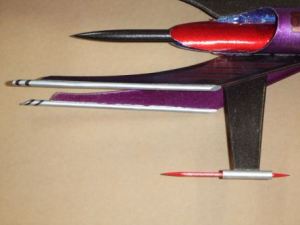
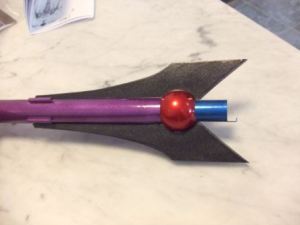
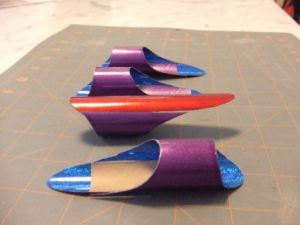
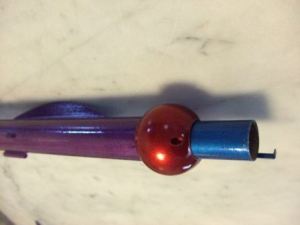
For the black and silver, I used Rustoleum metallics. By metallic, I mean the stuff that has a glittery/sparkling appearance, not the stuff that has a smooth mirror-like gloss. For example, the black is 7250 midnight black metallic. It's a wonderful paint for certain types of rockets, and this is one of those. FWIW, I think it's also the perfect paint for the Alien 8 and Night Whisper, two other futuristic Fliskit models.
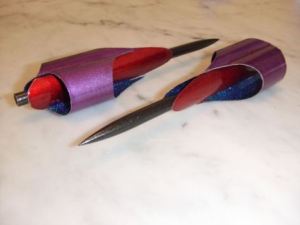 For
the other colors, I used Krylon X-metal paints, which claim to produce an anodized-looking finish. They do tend to
result in pretty good metallic finishes, though with that sparkle/glitter, not a mirror shine. They require a special
primer which is a silver metallic base coat. While I do generally like the finished color, they are almost translucent
and therefore do not cover well. They also are more prone to runs than other Krylons and they really hate being sprayed
in the cold. For most of this model, I've got two primer coats only lightly sanded, and at least 3, in some cases 5
finish coats. With 5-7 coats of paint, there are still some slight traces where you can spot the pencil lines I drew on
the unpainted tubes. You can also see the spirals, not because they aren't filled, but because the filler is a
different color than the tube and took the paint differently. This is all only apparent at very close examination,
though--from a foot away it's a fantastic looking model.
For
the other colors, I used Krylon X-metal paints, which claim to produce an anodized-looking finish. They do tend to
result in pretty good metallic finishes, though with that sparkle/glitter, not a mirror shine. They require a special
primer which is a silver metallic base coat. While I do generally like the finished color, they are almost translucent
and therefore do not cover well. They also are more prone to runs than other Krylons and they really hate being sprayed
in the cold. For most of this model, I've got two primer coats only lightly sanded, and at least 3, in some cases 5
finish coats. With 5-7 coats of paint, there are still some slight traces where you can spot the pencil lines I drew on
the unpainted tubes. You can also see the spirals, not because they aren't filled, but because the filler is a
different color than the tube and took the paint differently. This is all only apparent at very close examination,
though--from a foot away it's a fantastic looking model.
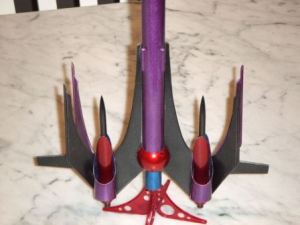
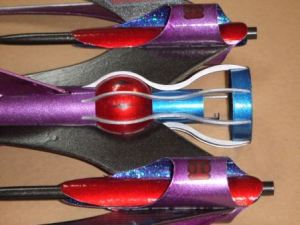
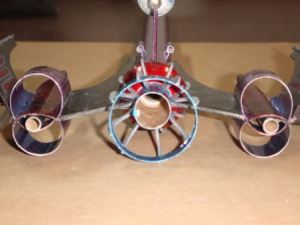 There are some waterslide decals included in this. They go on easily, but I've got to pan them a bit as
the weakest aspect of the kit. On the cover, they add some excellent accent trim. When applied to anything other than
very light colors, though, they fade into the background. On the black surfaces, they'd be invisible. These really need
to be silk screened and/or printed over a base coat of white, something that I believe is currently being considered
for the next batch of kits.
There are some waterslide decals included in this. They go on easily, but I've got to pan them a bit as
the weakest aspect of the kit. On the cover, they add some excellent accent trim. When applied to anything other than
very light colors, though, they fade into the background. On the black surfaces, they'd be invisible. These really need
to be silk screened and/or printed over a base coat of white, something that I believe is currently being considered
for the next batch of kits.
Construction Rating: 4 out of 5
Flight:
After all the work to build and finish, I was anxious to get in the first flight, so I braved the elements and
schlepped out on a cold winter day. Highs in the teens, winds 6-8 mph, 4-5 inches of fresh snow cover. I've got a stash
of C5-3's to burn down, so substituted one of those for the recommended C6-3.
Boost was straight up in the moderate winds, with a little bit of a roll on the way up, maybe 2 rotations. Apogee was in the neighborhood of 300-350 feet, and while the delay was a little early, that's what you want (versus nose down) in terms of deployment on something like this with lots of do-dads sticking out to snag a shroud line.
Recovery:
I hadn't realized it at the time, but this kit apparently features voice-activated dual deployment, clearly another
element of the advanced alien technology reflected in the design. When the ejection charge fired, the chute came out,
but as is often the case with plastic chutes in cold weather, it decided to stick closed. The rocket descended
horizontally, though, so I wasn't too worried, but was joking to the handful of fellow flyers watching that it was dual
deploy. At about 75 feet, I said "and now is when the main should be deploying", at which point the stuck
chute decided to unfurl, right on cue. Just enough time to slow it down for a perfect landing within 25 yards of the
pad.
Flight Rating: 5 out of 5
Summary:
What can I say? This is a wild and cool design and a very enjoyable build, though can be very challenging to paint,
and it flies great. The decals are definitely a con, though a small one. It has jumped up near the top of my favorite
Fliskits models, and I highly recommend it for the experienced modeller.
Overall Rating: 4 out of 5
 |
 |
Flights
Sponsored Ads
 |
 |











